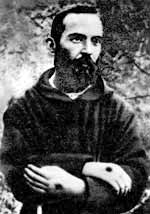Today is the feast of St. Pio of Pietralcina, known to most of his devotees as simply Padre Pio. He received the stigmata (the wounds of Christ) at a very young age and they remained until he died. Ironically, as this bio notes, he lived sick and died healthy, with the stigmata healed.
Despite the stigmata, he was in many ways, just a simple priest.
I’m named after him; so when I had the opportunity to visit San Giovanni Rotondo, where he lived most of his life as a Capuchin and a priest, I went. It was kind of an oddball trip. My friend had attended Mass at a nearby parish in Rome where she heard of this free tour. She signed us up and we were crossing Italy on a pullman bus (tour bus) with a bunch of older Italians. We hardly spoke any Italian ourselves. There was a bit of contest between a few of the Italian women to get the microphone so that they could talk to the whole bus. For the record, karaoke on a Korean tour bus is more fun. But the food on this bus was pretty good.
What impressed me the most about my visit was this plaque at Padre Pio’s tomb inscribed with words from Pope Paul VI.
My very basic translation –
May you enjoy the miracle that happened for Padre Pio. (May the same thing happen to you that happened to him.) Look at the fame he had! The people who came from all around the world to see him! But why, perhaps because he was a philosopher? Because he was scholar? Because he had great wealth (means)?
Because he offered Mass humbly, heard confessions from morning til evening, and he was, it’s difficult to say, a representative, marked by the stigmata of Our Lord.
He was a man of prayer and of suffering.”
Paul VI, Rome, February 20, 1971
I’m certainly not intending to dissuade any priest or future priest from studying and being a scholar. But, at the end of the day, that’s not what makes the priest. The priest is someone who is there to offer the sacraments, particularly in the Eucharist and in confession. And he’s also standing in persona Christi [in the person of Christ] not just with regard to the sacraments, but as to how he lives his life: prayer and suffering.
In another way, one could say that this life of prayer and suffering applies to all of the baptized since we participate in the common priesthood of Christ. (Catechism of the Catholic Church 1546-48)
Regardless, I think Paul VI’s message was pretty simple. Yes, Padre Pio received the stigmata, a big deal and a huge grace. But at the core he was a simple priest, he practiced holiness in the everyday details that he faced, a theme echoed by many saints, particularly those who are more contemporary.

